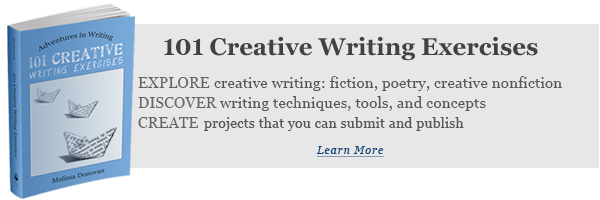Today’s writing exercise comes from my book, 101 Creative Writing Exercises, which takes you on an adventure through the world of writing. You’ll explore different forms and genres while learning practical writing techniques. You’ll also get plenty of writing experience and ideas for publishable projects.
Each chapter focuses on a different form or writing concept: free writing, journaling, memoirs, fiction, storytelling, form poetry, free verse, characters, dialogue, creativity, and writing articles and blogs are all covered.
Today, we’ll take a peek at “Chapter 3: People and Characters” with an exercise called “Your Gang.” Enjoy!
Your Gang
Writing about one or two people in a story or piece of nonfiction isn’t too hard. Even a scene with three or four characters can be well executed by a beginning writer. When you start approaching casts and ensembles with seven, eight, nine primary characters, you risk turning your story into a riot. Everybody gets out of control.
Ensemble stories in fiction tend to be epics; they span long periods of time (sometimes several generations). Often in these stories, there are many main characters but only a few are in focus at any given time. You’re more likely to find a good ensemble on television or in a movie than in a novel. But in all mediums, there are great stories about groups and families.
Writing a true ensemble piece requires considerable mastery in writing. As the author, you have to constantly keep all your characters in play, rotating them and managing their complex personalities. You can’t forget about any of your characters and you can’t let any of them hog the spotlight. It’s a balancing act.
The Exercise
Choose an existing ensemble from a book, movie, or TV show and write a long scene or a short story featuring all of the characters. Don’t retell some story about the characters from the source material. Take the existing characters and make up your own story or scene for them.
As an added challenge, relocate the characters to a different setting. For example, take the cast from a book and put them in the setting of a movie.
The minimum number of characters you should work with for this exercise is six. Aim for eight.
Tips: You can write big scenes with all characters present. You can also put the characters in different locations and write a series of scenes that take place in these various locations. One example would be a huge family gathering for a holiday weekend. The characters will disperse to different rooms. You have to move through the house showing the reader what everyone is doing, and it all has to tie together in a meaningful way.
Variations: Come up with your own ensemble. Write a series of short character sketches and establish a setting in which these characters would be thrown together. They could be family, coworkers, passengers on a subway, or students in a classroom. You can also attempt this exercise with real people and write either a scene from a real-life experience or make up a scene featuring your friends and family (a holiday gathering, school field trip, or work meeting). Make sure you give all the characters equal weight. Remember, it’s an ensemble.
Applications: If you can write an ensemble scene, you might be suited for television writing!






It’s ironic that this piece would be the highlight this week. my second novel that I have been pounding on for months now, falls directly into this catagory. An epic ensemble. You are so right about the difficulty in keeping all of the characters active yet not flooding the work with everyone.
This latest work encompasses the life of a chief (the Protag) of a new tribe of natives he has inherited. Many individuals, do make the work quite a bit more challenging, but in another way, they can add great volumn and help to . . .(add color) to the piece when a long stretch of dialog, or a endless description needs to be broken up somehow. This has been a helpful and informative post. I will save this one to the favorite list! Thanks
I agree, Michael. Writing an ensemble requires additional work, especially if you take the time to know your characters inside and out. Yet an ensemble can enrich a story because you have so many characters to draw from. Lots of players on the board creates extra opportunity for conflict!
Thanks for the peek in your book Melissa! I took a break from working on my WIP to read this post and I’m so glad I did – I now feel excited to write a big family party scene that I’ve been skirting around in my piece. Generally I find that when I have too many characters in a scene, they just disappear (ie. go silent or get distracted by something) if they are not a part of the main action. I feel that giving them more individuality will make them more present, even if they aren’t necessarily speaking or acting. Looking forward to diving into the scene!
Aziza, I’m glad this post inspired you! One of the great things about writing is that we can always revise. If you find your characters disappearing out of a scene, you can always go back and rewrite. I wish you the best of luck with your WIP!